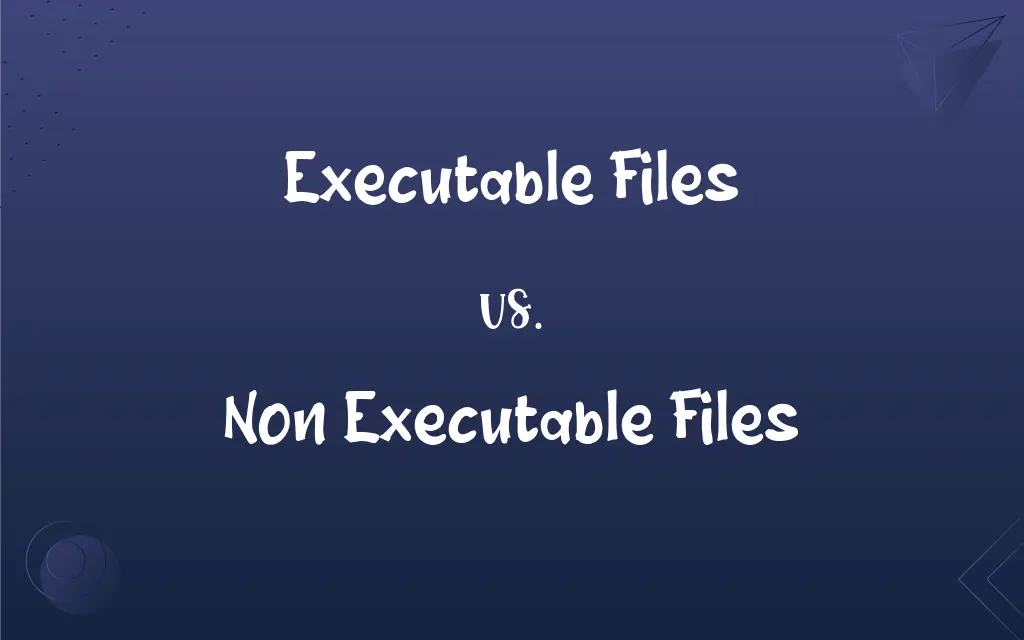Executable Files vs. Non Executable Files: What's the Difference?
Edited by Aimie Carlson || By Harlon Moss || Updated on October 25, 2023
Executable files contain instructions for a computer to execute; non-executable files don't.

Key Differences
Executable files are a class of files specifically designed to instruct the computer on performing certain tasks or operations. When a user or a system triggers these files, they start a program or process. On the contrary, non-executable files serve primarily as data containers. They hold information but lack the ability to initiate any action by themselves.
In the digital realm, executable files often have extensions like .exe, .bat, or .sh, signaling their capability to execute operations. Non-executable files, conversely, could have a myriad of extensions such as .txt, .jpg, or .pdf, indicating they serve to store text, images, or documents, respectively, without any inherent execution ability.
While executable files are vital for running software, games, or system processes, they also carry risks. Malicious software, often hidden in deceptive executable files, can harm systems. Non-executable files, while generally safer, can still be weaponized if they exploit certain software vulnerabilities when opened.
It's essential for users to be cautious with executable files, especially when sourced from untrusted locations. Non-executable files, although safer, should also be approached with caution as certain file types might be exploited to deliver payloads if associated software has vulnerabilities.
Comparison Chart
Purpose
To run or execute operations
To store data or information
ADVERTISEMENT
Typical Extensions
.exe, .bat, .sh
.txt, .jpg, .pdf
Risk Potential
Can contain malicious code
Generally safer but can have vulnerabilities
Dependency
Might need runtime environments
Often dependent on specific software to open
User Interaction
Can run without opening a document
Requires a program to display content
Executable Files and Non Executable Files Definitions
Executable Files
Can be standalone or part of larger software suites.
Some utility tools are single executable files that perform specific tasks.
ADVERTISEMENT
Non Executable Files
They are generally safer but can exploit vulnerabilities in specific software.
A specially crafted non-executable file can crash its associated software.
Executable Files
Their execution can be triggered by user actions or system events.
Some executable files run automatically when the computer starts.
Non Executable Files
Non-executable files are data containers without inherent action capabilities.
A .txt document holds text but doesn't perform tasks.
Executable Files
They're the actionable components in software applications.
Installing new software involves executing its executable files.
Non Executable Files
Their content often requires specific software to be viewed or edited.
You need a specific reader to open non-executable files like .pdfs.
Executable Files
Executable files are digital entities that initiate software or processes.
When you click an .exe file, a software program starts running.
Non Executable Files
Unlike executable files, they don't start programs or processes.
Listening to music involves playing non-executable files.
Executable Files
Executable files contain coded instructions computers understand and execute.
Launching a game often requires running its executable files.
Non Executable Files
They primarily serve to store information, not to initiate operations.
Your vacation photos are non-executable files.
FAQs
Do non-executable files perform operations?
No, non-executable files primarily store data and lack execution capabilities.
Are non-executable files completely safe?
While generally safer, non-executable files can still be weaponized through certain software vulnerabilities.
Why do some software require multiple executable files?
Complex software may have different components, each needing its own executable file.
What are executable files?
Executable files are files that contain instructions for a computer to execute or run.
Can executable files be dangerous?
Yes, if malicious, executable files can harm computer systems.
Can I change the extension of non-executable files without issues?
Changing extensions might make the file unrecognizable to its default software.
How do I open non-executable files?
Non-executable files require specific software or applications for viewing or editing.
How are executable files created?
They're often results of compiling source code written in programming languages.
Should I regularly scan executable files for malware?
Yes, regularly scanning helps ensure the safety of your computer system.
Is there a way to repair non-executable files?
Depending on the damage, some files can be repaired using specific software tools.
Can I send non-executable files safely over email?
Generally, yes, but it's best to ensure they don't contain sensitive information.
Why are executable files critical for a computer system?
Executable files run software and system processes vital for the computer's operation.
Do non-executable files take up less storage?
Not necessarily. The size depends on the data, not its execution capability.
Do all operating systems use the same executable file types?
No, different systems have different executable file standards (e.g., .exe for Windows).
Can I convert a non-executable file to an executable one?
Not directly, but software can be created to read non-executable data and perform tasks.
Can I create my own executable files?
Yes, with programming knowledge, you can write and compile code into executable files.
Are documents and images examples of non-executable files?
Yes, they store data without inherent execution abilities.
What's the significance of file extensions in executable files?
They often indicate the file's purpose and which program or OS can execute it.
Why do some executable files not open?
They might be corrupted, incompatible, or missing dependencies.
Can non-executable files become corrupted?
Yes, factors like software crashes or disk errors can corrupt non-executable files.
About Author
Written by
Harlon MossHarlon is a seasoned quality moderator and accomplished content writer for Difference Wiki. An alumnus of the prestigious University of California, he earned his degree in Computer Science. Leveraging his academic background, Harlon brings a meticulous and informed perspective to his work, ensuring content accuracy and excellence.
Edited by
Aimie CarlsonAimie Carlson, holding a master's degree in English literature, is a fervent English language enthusiast. She lends her writing talents to Difference Wiki, a prominent website that specializes in comparisons, offering readers insightful analyses that both captivate and inform.































































